The Curious Case of the Disappearing Video Archive
Nothing brings civic attitudes into sharper relief than a civil-rights test case. It doesn’t have to be about race — a case about the rights of people with disabilities serves just as well.
By Peter Monaghan
Take the curious matter of the “disappearing” University of California at Berkeley videos. It’s an episode that has served as a lightning rod of opinion about how far the Americans with Disabilities Act of 1990, and subsequent legislation and regulations, should go in requiring that archives of educational videos be as available to people with disabilities as to other users.
For several years, Berkeley built an archive of filmed course lectures and other educational materials — images relating to classroom experiments, graphs, and the like — initially for use by students on campus. Then, campus officials made the material freely available to the public. Eventually, Berkeley offered some 13,800 hours of material, some through free, public massive open online courses, MOOCs, which in recent years have become higher education’s nifty offering du jour.
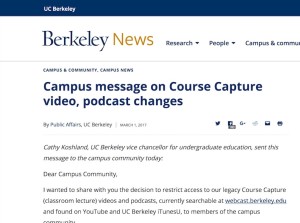 Last month [March 2017], however, Berkeley officials began to remove all the material from public access — some 20,000 video and audio files posted on a YouTube channel, iTunes U, edX (the platform of a non-profit organization that hosts MOOCS for institutions far and wide), and the university’s web channel, webcast.berkeley.edu.
Last month [March 2017], however, Berkeley officials began to remove all the material from public access — some 20,000 video and audio files posted on a YouTube channel, iTunes U, edX (the platform of a non-profit organization that hosts MOOCS for institutions far and wide), and the university’s web channel, webcast.berkeley.edu.
Now, Berkeley is restricting access to the material to students, faculty members, and others affiliated with the university.
The university is taking this action as the result of a finding by the Department of Justice’s Civil Rights Division, which received a complaint that the public material was inaccessible to people with disabilities, and therefore was in violation of the ADA.
The Office found that, indeed, many of the videos did not have captions or other ways for people with hearing disabilities to access images and other visual information such as graphs, charts, animations, and displayed URLs. Many online-course documents were not formatted to make them accessible to people with vision disabilities who use screen readers. Some videos had inaccurate or incomplete auto-generated captions. Many images could not be properly seen by people with color blindness.
The Justice Department told Berkeley officials that if the university was to host the material, it had to be accessible. Berkeley Vice Chancellor for Undergraduate Education Cathy Koshland announced in a September 2016 statement that “in many cases, the requirements proposed by the department would require the university to implement extremely expensive measures to continue to make these resources available to the public for free.” Koshland announced early in March 2017 that the university would opt, instead, to restrict the material to users with University of California credentials, during and after its transfer during the next few months to a password-protected platform.
Many users of the material, along with commentators who likely hadn’t even known it existed, are denouncing the Department of Justice’s action. They claim that the Americans with Disabilities Act should not be enforced at what they characterize as “the expense of people who do not need any accommodations due to disabilities.” Some proclaim that the Department of Justice directive is akin to book burning, and a classic example of government overreach.
what is the ADA?
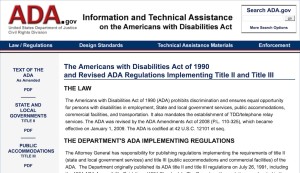 The Americans with Disabilities Act of 1990 prohibits discrimination against and seeks to ensure equal opportunity for persons with disabilities in employment, state and local government services, public accommodations, commercial facilities, and transportation.
The Americans with Disabilities Act of 1990 prohibits discrimination against and seeks to ensure equal opportunity for persons with disabilities in employment, state and local government services, public accommodations, commercial facilities, and transportation.
The precise definition and boundaries of the law are often in dispute — what counts, for example, as a “public accommodation”? Lawmakers and regulators at the Civil Rights Division have sought, over the years, to clarify some of the law’s perhaps inevitable cloudiness. For example, a “Final Rule” signed into law in November 2016, and in effect since January 2017, requires movie theaters to provide patrons, upon request, with the means to access closed captioning and audio descriptions in those cases where producers loaded those into their films.
the ADA is an idealistic attempt to ensure that people with disabilities receive “reasonable” accommodations – in the public sector and in the private
The Department of Justice had judged, then, that Berkeley would not suffer an “undue” burden if it made changes to its online video archive in keeping with Titles II and III of the ADA, along with Section 504 of the Rehabilitation Act of 1973, which require that “public universities must afford individuals with disabilities an equal opportunity to benefit from any aid, benefit, or service provided to others.”
why is there an ADA?
An obvious point often advanced in discussions of disabilities is that, eventually, most humans experience them. It is, however, famously difficult to gauge how many Americans have, at any one point in time, disabilities that require accommodations if they are to be well included in everyday life. One figures often cited is that around one-fifth of people have a disability that the ADA covers.
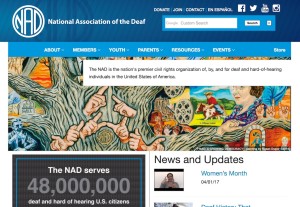 The National Association of the Deaf’s claim that about 48 million Americans (about 15 percent of the population) are deaf or hard of hearing is based on research at Johns Hopkins University which found that “nearly a fifth of all Americans 12 years or older have hearing loss so severe that it may make communication difficult.” The researchers analyzed data from the National Health and Nutritional Examination Surveys; those periodically gather health data from a statistically representative sample of the US population. The NHANES tested people and measured “hearing loss” according to the World Health Organization’s definition: being unable to hear speech of 25 decibels or less. By that measure, about 30 million Americans, or 12.7 percent of the population, had hearing loss in both ears, and about 48 million, or 20.3 percent, had hearing loss in at least one ear.
The National Association of the Deaf’s claim that about 48 million Americans (about 15 percent of the population) are deaf or hard of hearing is based on research at Johns Hopkins University which found that “nearly a fifth of all Americans 12 years or older have hearing loss so severe that it may make communication difficult.” The researchers analyzed data from the National Health and Nutritional Examination Surveys; those periodically gather health data from a statistically representative sample of the US population. The NHANES tested people and measured “hearing loss” according to the World Health Organization’s definition: being unable to hear speech of 25 decibels or less. By that measure, about 30 million Americans, or 12.7 percent of the population, had hearing loss in both ears, and about 48 million, or 20.3 percent, had hearing loss in at least one ear.
In a demonstration of how people struggle along with the faculties that they have, far fewer Americans self-report that they have hearing loss. The US Census Bureau reported that in the 2010 national census of the country’s then 308.7 million people, only 7.6 million people — about 2.5 percent — reported that they experienced difficulty hearing, including 1.1 million whose said their difficulty was severe. About 5.6 million used a hearing aid, which presumably could explain much of the disparity between NHANES and Census Bureau numbers of people experiencing difficulty hearing.
Disparities in such counts results at least in part from uncertainty over individuals’ versus medical practitioners’ measurements and bases for findings. This is merely to observe that estimating the number of people with disabilities is a complex matter. One source of confusion is that people without disabilities often are inclined to suppress numbers. They may, for example, parse from the same 2012 Census Bureau report a finding that only about one measly percent of Americans have “severe difficulty” hearing or seeing.
the goal of the ADA is to try to construct a certain kind of society: one in which as many people as possible can take part — hardly a complicated concept
In 2010, 11.9% of students who completed the University of California at Los Angeles’ respected annual survey of first-year college and university students reported having one or more disability. How does that proportion break down, by type of disability? In the 2014 UCLA survey, 3.7 percent of students reported having speech, sight, mobility, hearing, or other physical disabilities, while another 3.3 percent reported having learning disabilities such as dyslexia, 0.7 percent were on the autism spectrum, and 2.2 percent had chronic illnesses such as cancer, diabetes, or autoimmune disorders. In addition to those students, totalling 9.9 percent, were another 5.9 percent reporting attention deficit hyperactivity disorder, 7.4 percent reporting psychological disorders, and 4.7 percent reporting “other” disorders. Unsurprisingly, the number of undergraduates with disabilities among military veterans was higher — 21 percent.
The ADA tasks universities and colleges, like American society as a whole, with doing what they can to permit those students — who qualify for admission on the same basis as any other students — to have the opportunity to benefit from an education like any other students.
Berkeley and the ADA
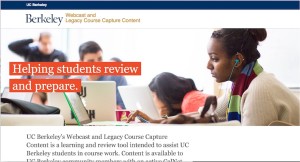 Berkeley initially began to create its video archive for its students — those who needed help accessing lectures and supporting material, and those who wished to review lectures after being unable to rouse themselves from bed to attend them. Berkeley made the recordings by deploying a Classroom Capture system, a “common-good lecture-capture service” that generally entailed automated filming from one camera in the rear of each of about 50 general-assignment classrooms.
Berkeley initially began to create its video archive for its students — those who needed help accessing lectures and supporting material, and those who wished to review lectures after being unable to rouse themselves from bed to attend them. Berkeley made the recordings by deploying a Classroom Capture system, a “common-good lecture-capture service” that generally entailed automated filming from one camera in the rear of each of about 50 general-assignment classrooms.
Each year Berkeley recorded and published to its various platforms nearly 4,500 lecture videos, eventually placing them in open, public access. But, according to the university, preparation of the material for public distribution — monitoring and editing to tidy up the material and ensure it conformed with privacy and intellectual-property law — required an average of 15 minutes of staff time, and that cost the institution some $300,000 a year. (With regards to intellectual-property law, universities are often very conservative when it comes to YouTube postings and the like, and hesitate to assert their fair-use rights.)
In April 2015, the university announced that it would stop adding material to the archive, and would restrict what was already in it to the campus community. It would continue to record lectures and other activities, but restrict the viewing of those to enrolled students, too.
As for public offerings, Berkeley said it would concentrate on its free MOOC courses, with their slicker and far less scattershot video postings. That would bring Berkeley into line with common practice at colleges and universities.
Over time, Berkeley has offered 42 courses via edX, the MOOC platform, which Harvard University and the Massachusetts Institute of Technology founded in 2012, but it offers only three, at the moment [April 2017]. So, with the removal of “legacy content” dating from 2006 to 2015, the loss of content from availability to members of the general public without disabilities is real, even if much of the subject matter is covered in MOOCs offered by one institution or another.
Among Berkeley’s concerns, officials said, was that internet “pirates” were helping themselves to legacy content and using it in commercial or advertising-carrying services, “without getting permission from the copyright holder.” That seems unlikely to have been a common problem; in any case, if Berkeley had, as it told The Chronicle of Higher Education in 2015, taken pains to excise copyrighted material from postings, then the only remaining copyright holder would have been the university, its employees subsumed.
the Department of Justice steps in
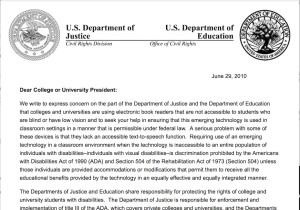 The Department of Justice Civil Rights Division has been trying to alert colleges and university, for quite some time, that they have been lagging in satisfying ADA requirements. In 2010, for example, the Division sent a letter to presidents of all higher-education institutions that made perfectly clear that adherence was required. Citing statutes, the Division addressed the presidents in such language as: “It is unacceptable for universities to use emerging technology without insisting that this technology be accessible to all students.”
The Department of Justice Civil Rights Division has been trying to alert colleges and university, for quite some time, that they have been lagging in satisfying ADA requirements. In 2010, for example, the Division sent a letter to presidents of all higher-education institutions that made perfectly clear that adherence was required. Citing statutes, the Division addressed the presidents in such language as: “It is unacceptable for universities to use emerging technology without insisting that this technology be accessible to all students.”
The letter reads like those of professors putting students on notice that assignments handed in late would no longer be accepted.
Berkeley fell foul of Civil Rights Division enforcement in the same sort of way other institutions have, in recent years — among them Harvard University, the Massachusetts Institute of Technology, Youngstown State University, the University of Cincinnati, Louisiana Tech University, and edX itself. The problems are long standing, and often go unaddressed. In 2010, The Chronicle of Higher Education reported a raft of shortcomings in colleges’ and universities’ online access, with many institutions failing to take effective steps to ensure compliance. (Web accessibility consultant Karl Groves maintains a list of web accessibility related litigation and settlements.)
Through the National Association of the Deaf, a doctoral student and an employee at Gallaudet University, an institution in Washington DC for people who are deaf or hard of hearing, complained that much of the material in Berkeley’s video archives was inaccessible.
The Department of Justice investigated. It analysed videos and courses on Berkeley’s YouTube channel and on iTunes U., as well as postings relating to Berkeley’s then-numerous MOOCs, and found many problems.
Violations of federal disabilities law included that significant portions of its online content were not provided in an accessible manner when necessary to ensure effective communication with individuals with hearing, vision, or manual disabilities.
As a result, the university would need to take steps so that its postings would “meet higher accessibility standards as a condition of remaining publicly available.”
how did Berkeley respond?
In September 2016, Berkeley responded. Berkeley Vice Chancellor for Undergraduate Education Cathy Koshland said in her statement, with regards to the cost of coming into compliance: “We believe that in a time of substantial budget deficits and shrinking state financial support, our first obligation is to use our limited resources to support our enrolled students. Therefore, we must strongly consider the unenviable option of whether to remove content from public access.”
She said that would not prevent the university from continuing to offer the archive on campus, because “the department’s findings do not implicate the accessibility of educational opportunities provided to our enrolled students.”
Koshland announced early in March 2017 that “we have determined that instead of focusing on legacy content that is 3-10 years old, much of which sees very limited use, we will work to create new public content that includes accessible features.”
She added: “Since fall 2015 we have piloted publishing all of our Course Capture content behind CAS/CalNet authentication. This strategy has enhanced our ability to accommodate students and UC Berkeley community members who have demonstrated an accessibility need.”
Reading between the lines of Vice-Provost Koshland’s statement, it seemed that the institution was taking the Department of Justice finding as an opportunity to step back from trying to be so much of a leader of higher education’s general-public-programming pack. She said: “Berkeley will maintain its commitment to sharing content to the public through our partnership with EdX. This free and accessible content includes a wide range of educational opportunities and topics from across higher ed.” That seemed to say: Berkeley would relinquish its claim on leading the sputtering MOOC revolution and leave to colleges and universities, as a sector, the task of providing such public programming.
Berkeley’s announcement of its decision was almost exclusively read, however, as a lament at the harshness of Justice’s ruling. And it provoked an avalanche of criticism of the Office for Civil Rights. Many academics, from across higher ed, as well as many technology observers, journalists, and self-appointed pundits took sides, some for the Office for Civil Rights, most against it.
has Berkeley been victimized?
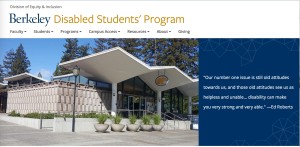 Many critics have presumed to make claims on behalf of Berkeley, such as that it has championed disability rights, and deserved better accommodation, itself. Berkeley’s Disabled Students Program and Educational Technology Services have for several years supported students who require assistance, such as captioning of videos.
Many critics have presumed to make claims on behalf of Berkeley, such as that it has championed disability rights, and deserved better accommodation, itself. Berkeley’s Disabled Students Program and Educational Technology Services have for several years supported students who require assistance, such as captioning of videos.
Still, the Office for Civil Rights did note in its letter to Berkeley that the institution hadn’t even followed its own rules. The Department of Justice noted that while the University of California Office of the President’s Information Technology Accessibility Policy required from 2013 that its campuses meet certain technical standards for assistive accessibility, Berkeley still had not. The standards long predated the University of California’s adopting them, and have for years been well known: they are the Web Content Accessibility Guidelines, known as WCAG 2.0. Berkeley provides for faculty members and other campus employees to avail of the services of the campus’s own Educational Technology Services or even those of outside vendor companies, to achieve WCAG 2.0 levels of accessibility.
But again, many had not.
All this brings into harsh light the claim of many observers that the fight against accessibility discrimination is undiscriminating, and Berkeley just its latest victim. That charge might seem plausible, if cast only in the context of how increasingly common federal ADA lawsuits have become. Some activists account, individually, for hundreds of the thousands of suits being filed each year.
Such actions “deprive the rest of us” and are “a brazen exercise in moral free-riding.”
The ADA, Ferguson wrote, was “a brazen exercise in moral free-riding” and “a feast for plaintiffs’ lawyers.” Only members of “a brave band of libertarians and constitutionalists” oppose it; only they see the advance of disability rights as “a gluttonous and unprecedented expansion of state power.”
Similar spleen dominates comments about the Berkeley matter in reader responses to articles, as in that brave libertarianosphere, broadly. At, for example, the Cato Institute, which champions “individual liberty, limited government, free markets and peaceful international relations,” Walter Olson, author of such books as The Excuse Factory and Schools for Misrule, argues that lawyers are gaming the system by filing frivolous suits. “They take advantage,” agrees Forbes’ columnist Preston Cooper, “of pliant regulatory bodies such as the Department of Justice or defendants wishing to avoid large legal expenses,” such presumably as the University of California.
is litigiousness, now, a factor?
Suing is the American way; so is persisting with discrimination for as long as courts and legislatures allow.
Some disabilities-rights activists make no secret of their resort to litigation, and even litigiousness. They say that history long ago left them little other option.
Lennard J. Davis, a professor of English, disability studies, and medical education at the University of Illinois at Chicago and author of Enabling Acts: The Hidden Story of How the Americans With Disabilities Act Gave the Largest US Minority Its Rights (Beacon Press, 2015), has explained plainly how that has proceeded, in the context of higher education.
After many veterans returned injured from World War II, he says, they and survivors of the polio epidemics of the 1950s began to demand access to higher education in the 1960s and 1970s. Momentum for enrollments by people with disabilities boomed after the passage of legislation in the 1990s, particularly the ADA.
colleges and universities, particularly those in the private sector, joined with business interests in hiring lobbyists to impede the ADA and other civil-rights legislation
They could take heart from history. In 1979, a U.S. Supreme Court ruling had “basically eviscerated early disability-rights provisions,” Davis writes. Then, the Court ruled in 1984 that institutions receiving federal funds “would not be punished across the board if only one department or office practiced discrimination.” That was, of course, a half-open invitation to discriminate, and its spirit was carried forward within opposition to the ADA, when it came along as a corrective, in 1990.
“It would be comforting to say,” writes Davis, “that colleges then stopped placing obstacles on the road to disability rights, but in fact ADA lawsuits brought by or against colleges continued. While many institutions of higher education complied superficially, many more did not actively develop plans for disabled students.”
And that recalcitrance continues, he notes. Reports are rife, for example, of colleges fighting against accommodation of students with learning disabilities and mental-health challenges: “Many students arrive on campus after being assured that their learning disabilities will be taken into account,” only to find that “assurances were not guarantees.” That has sparked numerous lawsuits in which “even colleges that have traditionally supported civil rights and antidiscrimination efforts have been implicated.”
If many colleges and universities still do not build accessibility into their budgets, the cost can be that they have to take down inaccessible material and services. It’s not a matter of the institutions being victimized despite their generosity to “the public.”
leading institutions entered the race to be leading online providers because the race was thought to be worth many billions of dollars, so to argue that the postings have some special status merely by force of having been made available free of charge is a legal nonsense
To pity colleges and universities is to cast them as disabled naïfs. But they are well equipped to compete, and to bargain. Indeed, Congress is now considering legislation aimed at lessening disabilities-related litigation, and limiting costs to defendants. The AIM-HE Act (Accessible Instructional Materials in Higher Education Act), was introduced in Congress in September 2016 after an earlier set of proposals, the TEACH Act (Technology, Equalilty, and Accessibility in College and Higher Education Act), introduced in Congress in 2013, failed to make progress due to concerns about its broad language and inflexibility. AIM-HE would produce voluntary guidelines — a compilation of carefully explained, internationally agreed best practices — that colleges and universities could adopt, in ways and degrees they chose. Adopting the guidelines fully would afford institutions a “safe harbor” from ADA and related litigation.
recourse: cursing, or fixing
Plenty of employers curse when told that they have to pay employees minimum wage; they say: “But then I can’t have a business.”
Plenty of homeowners make shoddy or unsafe additions; they say: “If I run it by those damned building inspectors, they’ll just say no.”
“We should work to make items more accessible, but not involve any form of what is essentially destroying libraries, burning books, and deleting data to occur.”
Similarly, a technology blogger wrote: “We should work to make items more accessible, but not involve any form of what is essentially destroying libraries, burning books, and deleting data to occur.”
Looks like the sky is falling down, because “our knowledge resources are under threat from unreasonable, flawed regulations.”
Who is the “we” of this “our”? Well, who it isn’t, according to critics of the Berkeley ruling, is those who “gain” from what those critics characterize, in as many words, or others, as “accommodating an incredibly small subset of the population.”
It certainly isn’t an inclusive “we” of a society of shared civil participation.
Why, persist some sour observers, haven’t members of the affected sub-population (by which they don’t mean, all of us) simply fixed the videos’ accessibility, themselves? Or, why doesn’t someone now launch a crowd-funding campaign, a digital barn-raising, to collect money to get the job done?
Berkeley, and many other institutions, would doubtless be willing to accept and happy to receive money for ADA-compliant projects, future or retrospective.
Meanwhile, plenty of faculty members and administrators are eager to learn how. In September 2016, when the State University of New York’s Buffalo State College and Empire State College jointly offered a MOOC about using Universal Design for Learning in courses, more than 1,600 people registered. Participants in such courses and workshops learn how much is known about how best to design course materials — not just which typefaces work best for people with dyslexia, and how to accommodate people on the autism spectrum, but how accessibility research reaps benefits for many kinds of students, including plenty who have never been described as having “disabilities.” It helps them to grasp course material better.
an online irony
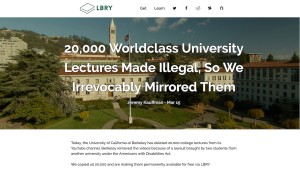 An irony of Berkeley’s removal of its video archive is that a curious new service, LBRY, modelled on Bitcoin and laying claim to being a “censorship-resistant way to exchange content” and really a “protocol” rather than service, has seized on the opportunity to seed its content banks by “mirroring” all 20,000 or so of the Berkeley videos, and making them available, still for free. LBRY is asserting that capturing the material in that way is “legal under the First Amendment” and because in any case “the vast majority of the lectures are licensed under a Creative Commons license.” In additions, says LBRY, “all LBRY metadata attributes [the content] to UC Berkeley.” (LBRY’s snatching up the material is, nonetheless, an odd move for a new company whose creators claim that among their “dramatically trustworthy” system’s key differences from, say, YouTube is that YouTube presumes “to push around its creators and users.”)
An irony of Berkeley’s removal of its video archive is that a curious new service, LBRY, modelled on Bitcoin and laying claim to being a “censorship-resistant way to exchange content” and really a “protocol” rather than service, has seized on the opportunity to seed its content banks by “mirroring” all 20,000 or so of the Berkeley videos, and making them available, still for free. LBRY is asserting that capturing the material in that way is “legal under the First Amendment” and because in any case “the vast majority of the lectures are licensed under a Creative Commons license.” In additions, says LBRY, “all LBRY metadata attributes [the content] to UC Berkeley.” (LBRY’s snatching up the material is, nonetheless, an odd move for a new company whose creators claim that among their “dramatically trustworthy” system’s key differences from, say, YouTube is that YouTube presumes “to push around its creators and users.”)
Meanwhile, Inside Higher Ed reported last month that various large public and private research universities with large online collections available to the public, some of which have already settled or face ongoing accessibility lawsuits, say they will not delete publicly available educational content, like Berkeley, even though their postings often rely on YouTube’s imprecise automatic captioning, or lack captions altogether. Those institutions that replied to Inside Higher Ed’s inquiry said they were working on accessibility.
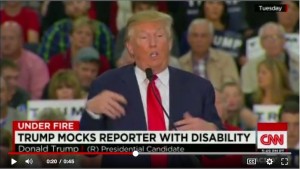 Several did not reply. Perhaps they are waiting to see how the wind will blow, under new US president, Donald Trump. It’s almost certain that under his direction the Justice Department will be less vigilant about disability laws. He is, after all, the president who publicly mocks people whom he perceives as having disabilities, and whose first nominee to the Supreme Court has shown himself to be hostile to their rights.
Several did not reply. Perhaps they are waiting to see how the wind will blow, under new US president, Donald Trump. It’s almost certain that under his direction the Justice Department will be less vigilant about disability laws. He is, after all, the president who publicly mocks people whom he perceives as having disabilities, and whose first nominee to the Supreme Court has shown himself to be hostile to their rights.
Previous Post: Has the Video Essay Arrived?
Next Post: Fixing Transcripts with the Crowd





